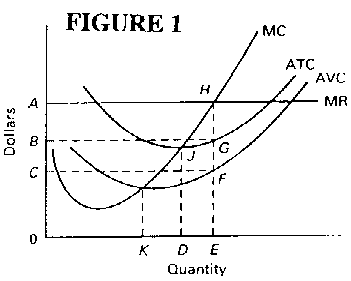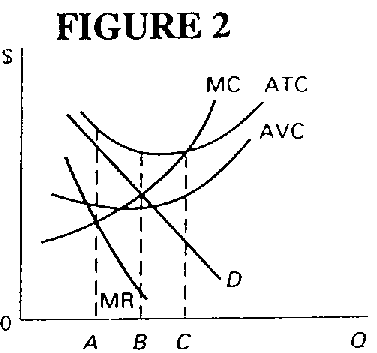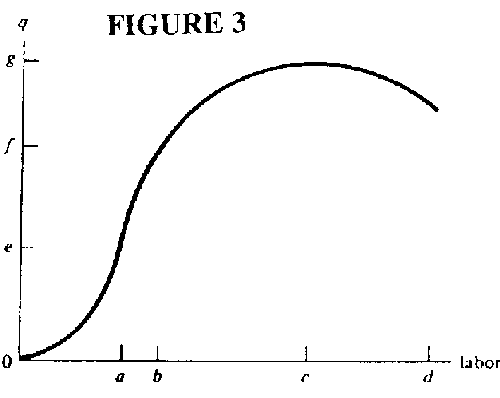SO 151
Bremmer
October 15, 1996
Second In-Class Exam - - Chapters 21-24
Part I. Multiple Choice Questions (3 points each). Indicate the best answer for each question in the space
provided.
- 1. Along a given production function, when total output (or total product) is increasing at an increasing
rate, the marginal product:
- A. is zero.
B. is less than average product.
C. is decreasing.
D. is not affected, because it is unrelated.
E. is increasing.
- 2. When marginal product is falling:
- A. average product must be falling.
B. marginal cost must be falling.
C. average product must be rising.
D. marginal cost must be rising.
E. total output must be falling.
- 3. The shape of the short-run marginal cost curve is determined by:
- A. economies of scale.
B. the law of diminishing marginal returns.
C. profit maximization.
D. diseconomies of scale.
E. the law of diminishing marginal utility.
- 4. If fixed cost is nonzero and marginal cost is constant for all levels of output, it is:
- A. less than average variable cost.
B. equal to average total cost.
C. greater than average variable cost.
D. equal to average variable cost.
E. Both B and D.
- 5. If a firm has economies of scale, its:
- A. long-run average cost curve will be increasing.
B. long-run average cost curve will be constant.
C. long-run average cost curve will be decreasing.
D. short-run average total cost curve will be constant.
E. short-run average total cost curve will be increasing.
- 6. Assuming a perfectly competitive , decreasing-cost industry initially in long-run equilibrium, a
decrease in demand will:
- A. cause the price to rise in the short run, but then fall to a equilibrium level below the original level as firms
enter the industry and costs fall.
B. cause price to increase in the short run, and price will further increase in the long-run as firms enter the
industry and costs rise.
C. cause price to fall in the short run, and continue to fall to a new equilibrium level below the original level in
the long run as firms exit the industry and costs fall.
D. cause price to fall in the short run, but then rise to a new equilibrium level above the original level in the long
run as firms exit the industry and costs increase.
E. have no effect on price in the long run.
- 7. Given a perfectly competitive, constant-cost industry, an increase in the cost of a variable input implies
in the short run:
- A. that both the firm and market supply curves shift to the right, market price decreases, market output
increases, each firm's output increases, and all firms earn economic profits.
B. that neither the firm or market supply curves shift, the market price remains unchanged, the market output
and the output of the typical firm are unaffected, and all firms incur losses.
C. that both the firm and market supply curves shift to the left, market price increases, both the market output
and the output of the typical firm decrease, and all firms incur losses.
D. that the market demand curve shifts to the left, market price will decline, both market output and the output
of the typical firm decline, and all firms incur losses.
E. that the market demand curve shifts to the right, market price will increase, both market output and the output
of the typical firm increase, and all firms earn economic profits.
- 8. Assume a perfectly competitive, constant-cost industry, has experienced an increase in the cost of a
variable input and it has already reached its new short-run equilibrium. In the adjustment to the new
long-run equilibrium:
- A. firms will enter the industry, the market supply curve shifts to the right, market price will decline, market
output will increase, and profits will be driven down to normal levels.
B. firms will exit the industry, the market supply curve shifts to the left, market price will increase, market
output will decrease, and profits will increase to the normal level.
C. market demand will shift to the right, market price and market output will increase, and profits will increase
so that all firms earn normal profits.
D. market demand will decrease, market price and market output will decrease, and profits will fall to the
normal level.
E. None of the above.

- 9. Referring to Figure 1, which depicts a perfectly competitive firm in short-run equilibrium, which of the
following statements is not true?
- A. At equilibrium, fixed cost is equal to CBGF.
B. At equilibrium, variable cost is equal to 0CFE.
C. At equilibrium, total revenue is 0AHE and total cost is 0BGE.
D. The market price is equal to 0A.
E. The firm will realize zero economic profits.
- 10. If the competitive firm decided in short-run equilibrium in Figure 1 belongs to an increasing-cost
industry, what will happen in the long run?
- A. The market price falls, and the ATC, AVC, and MC curves shift up.
B. The market price increases, and the ATC, AVC, and MC curves shift up.
C. The market price falls, and the ATC, AVC, and MC curves shift down.
D. The market price increases, and ATC, AVC, and MC curves shift down.
E. The market price falls, but the positions of the ATC, AVC, and MC curves are unaffected.
- 11. Compared to a perfectly competitive industry with the same cost structure, a monopoly will
charge:
- A. a higher price and sell more.
B. a lower price and sell more.
C. a higher price and sell less.
D. lower price and sell less.
E. the same price of a competitive industry and produce less.
- 12. If a monopoly is earning economic profits, then:
- A. new firms will enter the industry.
B. the monopolist will increase its price.
C. the profits will fall to the normal level as firms enter.
D. the profits will continue in the long run because of barriers to entry.
E. Both A and C.
- 13. If marginal cost increase, a profit-maximizing monopolist will:
- A. decrease price and increase output.
B. decrease both price and output.
C. increase price and decrease output.
D. keep both price and output at the same level.
E. increase both price and output.
- 14. If a monopolist increases output and total revenue increases, which of the following must be true?
- A. MR = 0.
B. MR > 0.
C. P = MC.
D. MR < 0.
E. MR < MC.

- 15. Refer to the profit-maximizing (or loss-minimizing) monopolist depicted in Figure 2. In the short
run, this monopolist:
- A. will shut down and incur a loss equal to, in absolute value, fixed cost.
B. will minimize losses, produce output 0B and incur a loss that is less than fixed value in absolute value.
C. produce output 0C and break even.
D. minimize losses, produce output 0A, and incur a loss that is less than fixed cost in absolute value.
E. leave the industry.
Part II. Short Answer Questions (55 points). Give a complete, but concise answer to each of the
following questions. Whenever possible, use graphs, math, or equations to help explain your answers.
1. "A firm experiencing economies of scale is under utilizing its current plant size." Explain. (10
points)
2. "A perfectly competitive firm faces a demand curve that is perfectly elastic while the
monopolist's demand curve is downward sloping." Explain. (10 points)
3. Briefly answer the following questions on the basis of the production function depicted in Figure
3 and the data therein. Just state the answer, a thorough explanation is not needed. (10 points)

A. At what level of variable input is marginal product equal to zero?
B. At what level of variable input is marginal product maximized?
C. At what level of output is average variable cost minimized?
D. Over what range of variable input does marginal product increase?
E. At what level of variable input does diminishing returns set in?
4. A typical firm in a competitive industry has the cost schedule below. Use this data to answer the
following questions. (10 points)
| Q |
0 |
1 |
2 |
3 |
4 |
5 |
6 |
7 |
8 |
9 |
10 |
| TC |
$150 |
200 |
225 |
255 |
295 |
350 |
420 |
510 |
625 |
770 |
950 |
| MC |
|
|
|
|
|
|
|
|
|
|
|
A. If a competitive firm faced with these costs finds that it can sell its product at $60 per unit, calculate
the firm's marginal costs at each level of output, and determine the profit-maximizing (or loss-minimizing) level of output. What is the firm's profit or loss? Briefly explain how you obtained
these results.
B. Based on your answer in part A above, what will happen to market price in the long run? Explain.
5. Below are the demand schedule and cost schedule of a pure monopolist. Use this data to answer the
following questions. (15 points)
| Price |
$15 |
14 |
13 |
12 |
11 |
10 |
9 |
8 |
7 |
6 |
5 |
Quantity
Demanded |
0 |
10 |
20 |
30 |
40 |
50 |
60 |
70 |
80 |
90 |
100 |
| TR |
|
|
|
|
|
|
|
|
|
|
|
| MR |
|
|
|
|
|
|
|
|
|
|
|
| Q |
0 |
10 |
20 |
30 |
40 |
50 |
60 |
70 |
80 |
90 |
100 |
| TC |
$250 |
280 |
310 |
340 |
370 |
400 |
430 |
460 |
490 |
520 |
550 |
| MC |
|
|
|
|
|
|
|
|
|
|
|
A. Determine the total revenue (TR), marginal revenue (MR), and marginal cost (MC) for each output.
What is the profit-maximizing (or loss-minimizing) level of output? Why?
B. Assume that President Clinton imposes a $150 tax on this monopolist. What will happen to the
monopolist's optimal level of output and level of profits? Why?
C. Assume president Clinton is steadfast and refuses to remove this tax. What will happen to the
monopolist in the long run? Why?


